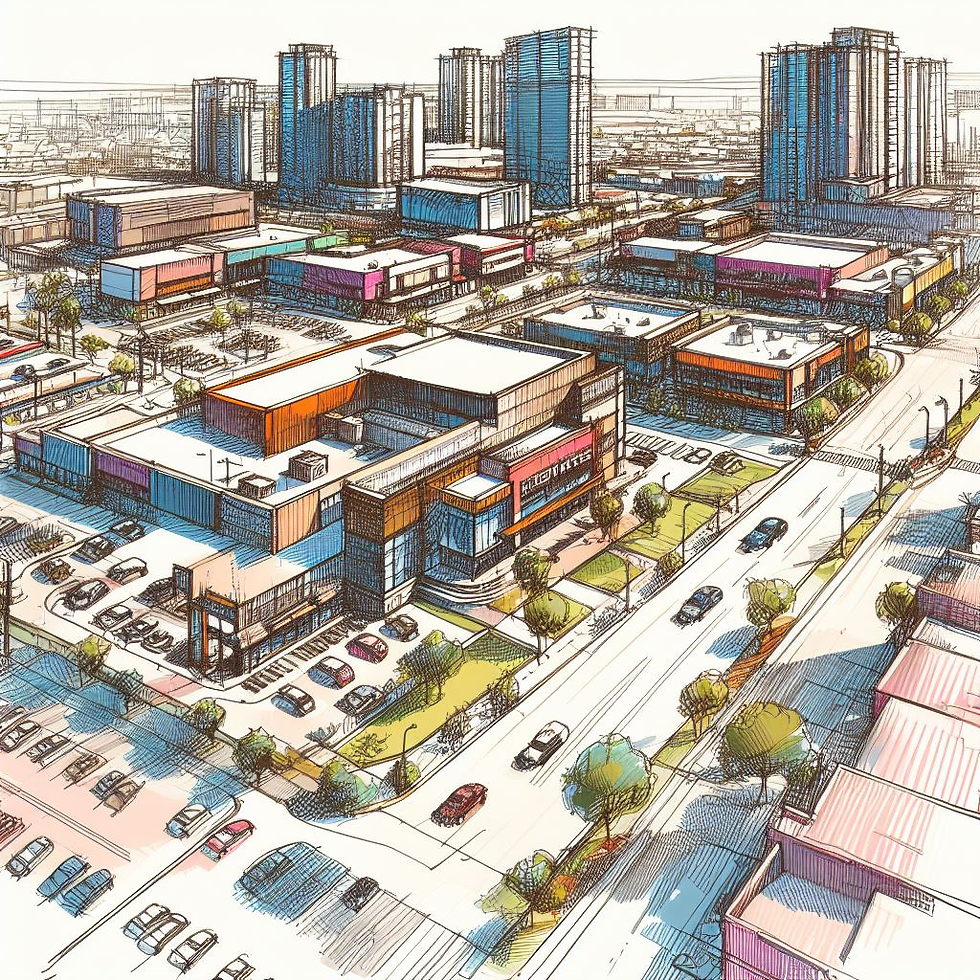Reimagining Suburbia - New Suburbanism and the Fusion of House and Store
- Dylan Kennedy
- Oct 12, 2023
- 4 min read
Exploring Innovative Spatial Synergies in Suburban Living and Retail. What's next for suburbs?

The American Dream, for generations, has been closely associated with the idea of suburban living. Suburbs have represented spacious single-family homes, white picket fences, and access to the conveniences of city life while enjoying the tranquility of the outskirts. However, as urbanization and environmental concerns reshape our cities, a new paradigm of suburban living is emerging. This paradigm is known as "New Suburbanism," and it challenges traditional notions of suburban design.
New Suburbanism
New Suburbanism is an innovative approach to suburban living that seeks to reinvigorate the suburbs while addressing issues such as sustainability, community engagement, and efficient land use. It is an evolution of suburban typologies that blend housing and retail, promoting mixed-use developments and promoting a more vibrant and sustainable lifestyle.

New Suburbanism represents a shift in suburban planning and development, challenging the conventional landscape in favor of a more community-centric approach. At its core, this movement seeks to create neighborhoods that prioritize access to green space, mixed land uses, and a sense of belonging among residents. One intriguing aspect of the movement is the fusion of big-box stores with single-family homes. Traditionally, these two elements have been kept separate in planning, with residential areas and commercial zones divided.
However, the integration of big-box stores, such as large retail chains or supermarkets, with homes in the same development offers several advantages for community residents. This combination can reduce the need for long commutes, as residents can easily access essential goods and services within walking or biking distance. Moreover, it encourages a semblance of economic diversity and helps build a stronger sense of community, as neighbors can meet at these shared spaces.

Comparing New Urbanism and New Suburbanism
New Urbanism and New Suburbanism represent distinct approaches to urban planning and development, each tailored to specific geographical contexts. New Urbanism places a strong emphasis on the rejuvenation of existing urban areas and the creation of densely populated, mixed-use neighborhoods within cities. It champions principles like walkability, diverse housing options, and the integration of commercial and residential spaces within compact, well-connected environments. This approach seeks to reduce automobile dependence, foster vibrant street life, and promote a sense of community. It often features traditional architectural styles and encourages the use of public transportation, helping cities adapt to the changing needs of a more sustainable and community-oriented future.
Conversely, New Suburbanism is geared towards suburban and exurban regions, aiming to modify traditional suburban landscapes. It endeavors to make suburban living more sustainable and connected by incorporating elements of New Urbanism, such as walkability and mixed land uses, into suburban settings. New Suburbanism typically maintains lower population density than urban areas but strives to achieve higher density compared to traditional, sprawling suburbs. It adapts to the recognition that cars are a significant part of suburban life, encouraging car-reduced living while still accommodating practical automobile usage. This approach underscores the importance of suburban communities, offering residents opportunities for communal interaction and sociable living, without entirely abandoning the suburban lifestyle.
Case Studies in New Suburbanism:
Avalon Park West in Florida: Avalon Park West is a New Suburbanism development designed with a focus on walkability, sustainability, and community engagement. The community features a town center with shops, restaurants, schools, and parks, all within walking distance of homes.
New Town in St. Charles, Missouri: Former open space and farmland has been redeveloped into an extensive single-family home development, incorporating a hybrid street grid of quasi-urban lot sizes and uses. The development is centered around a series of connections to ponds, and plaza space.
Stapleton in Denver, Colorado: This former airport site has been redeveloped into a sustainable suburban community that integrates residential neighborhoods, parks, schools, and shopping centers. Stapleton exemplifies New Suburbanism principles, focusing on creating a sense of community and walkability.

Shown Above: A concept sketch of new suburbanism, anchored by big box retail and entertainment. Parking and open space surround a small cluster of highrises.
The Shifting Landscape of Suburbia
The future of suburbs is undergoing a significant transformation as counties and municipalities surrounding large cities reimagine and repurpose their landscapes to attract a younger demographic increasingly drawn to urban living. Suburbs are evolving to offer a blend of urban-like amenities and traditional suburban comforts. This shift is driven by a desire to cater to a generation that values convenience, connectivity, and sustainability. As a result, we can expect to see a continued emphasis on mixed-use developments in suburban areas. Former shopping mall sites, which often occupy prime suburban real estate, are being repurposed into mixed-use centers that feature a combination of residential units, offices, entertainment venues, and green spaces. These reimagined spaces are designed to create a sense of community and serve as hubs where residents can live, work, and socialize—all within walking distance.
The Future of Suburban Living
The resonance of New Suburbanism with the values and aspirations of the next generation, marked by a focus on convenience, community, and sustainability, raises the question of how these ideals will shape the future of suburban living in the United States. Suburbs are at a crossroads, seeking to maintain their intrinsic appeal in a world where urbanization and environmental consciousness are increasingly defining the landscape. The challenge lies in understanding which aspects of New Suburbanism will endure and how they will weave into the fabric of the American Dream for generations to come.
Comments